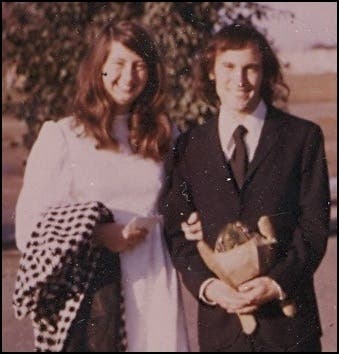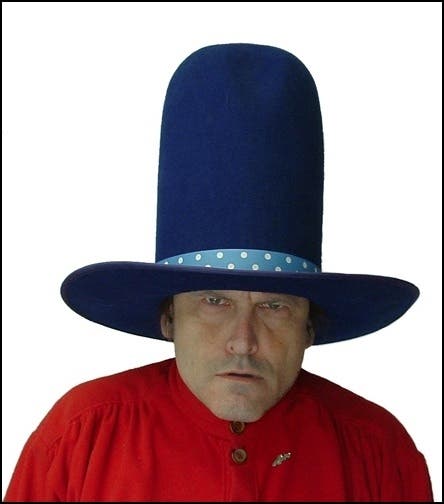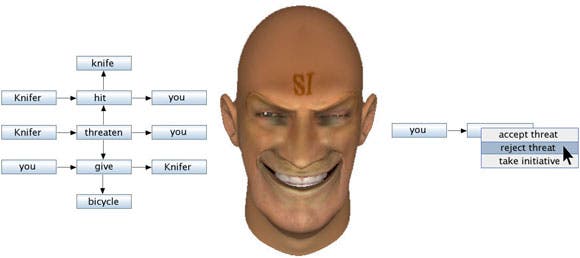Chasing the Dragon
From the archive: How legendary game designer Chris Crawford took himself to the brink in pursuit of his dream.
Every Sunday, we bring you an article from your archive that you may have missed first time around. This week, we present Lee Bradley's wonderful profile of Chris Crawford, the maverick designer who's dedicated his career to chasing a storytelling dream.
"Had I known the magnitude of the problem I would probably have turned away. If I had known that twenty years later I still would not have solved it, I wouldn't have attempted it. I thought it would take two or three years."
With a career stretching back to the late '70s, Chris Crawford is one of the founding fathers of video games. He's the lauded creator of a string of pioneering strategy titles, the author of the very first book devoted to game design and the creator of the Game Developers Conference. He is, in short, a legendary figure.
In 1992, however, Crawford found himself discontent with the industry he had helped establish, so he decided to speak out against it. Addressing an audience of his peers at that year's GDC, he gave a talk that would come to define both his life and his career. It was called The Dragon Speech.
The Dragon Speech was Crawford's impassioned call for change. He was disappointed in the direction that many designers were taking. He wanted games to be a medium for artistic expression, an aspiration he felt his contemporaries did not share. So he announced that he was leaving the industry in order to pursue that dream.

Crawford described his goal as the metaphorical slaying of a dragon. At the climax of the speech he grasped a sword, unsheathed it from its scabbard, held it aloft and cried "For truth! For beauty! For art! Charge!" - and galloped out of the room.
In many ways, Crawford never returned. Though he continues to flit around the outskirts of the industry, he hasn't made a traditional game since. Instead, he has dedicated his life to developing a method of interactive storytelling unlike anything the games industry has ever seen. But it's yet to work.
"The basic message of the Dragon's Speech was that I had pursued games with the expectation that they would eventually become a medium of artistic expression. But the games industry was moving in the opposite direction."
Two decades later and Chris Crawford's dragon is in danger of destroying his life. But to understand how he got to this point, we must first go back to the beginning.
"I had always been a player of war board games, where you maneuver the little cardboard characters across the map with a hexagonal grid," says Crawford of his first steps into game design. "I loved those games."
"But I always felt that they had a fundamental flaw in that they did not take into account the fog of war. That is, you could always see exactly what it was your opponent was up to, which is never the case in real warfare. And that really bothered me.
"So one day I realised that computers could handle that problem. And so I started teaching myself about them. I built a system and I programmed a war game to play on it. It was great fun and so one thing led to another and I just started making more games."
Crawford wasn't immediately successful. Despite developing and self-publishing a couple of titles as a hobbyist - "I was one of the first people on the planet to do that," he says - it wasn't enough to guarantee him a career. It was only when his wife Kathy picked up the Yellow Pages to help find him a job that he struck lucky. Running her finger down the page, the first name Kathy reached was Atari.

It was while working at Atari that Crawford began to make his name, creating seminal titles like Eastern Front (1941), in which players take control of troops during Germany's invasion of Russia in World War 2. It was one of the earliest strategy titles, bringing innovations in tactical depth as well as the first use of a scrolling map. Yet despite earning him huge praise and a number of awards, it wasn't enough. Crawford had bigger plans.
It was Alan Kay that set Crawford on the path of the dragon. A Turing Award-winner (the computer science equivalent of the Nobel Prize), Kay is a creator of concepts that would lead to laptops, tablets, windowed interfaces and e-books. He's a visionary and in the early 1980's he worked alongside Crawford in Atari's corporate research division.
"I realised that there was more going on here than just war games," says Crawford. "Alan pushed me really hard to aim high. One of his great quotes was, 'If you don't fail at least 90 per cent of the time, you're not aiming high enough.' So with Kay's words spurring him on, Crawford started putting together the next major step in his career.
Yet before he could do anything, disaster struck. The video game crash of 1983 ripped through the industry, the once mighty Atari crumbled and Crawford lost his job. "It got very desperate," he says. "I was laid off in March of 1984, Atari gave me a severance package and my wife and I tightened our belts."
Rather than cut his losses, Crawford started work on his next project alone, against the ticking clock of a dwindling bank balance. "Everything that I had done up to that point had been war games," he says. "So I wanted to do an un-war game. I wanted to make a game about geopolitics where it ended in a loss if a war started."
As development on the game rolled on, time was running out. "About a year in," says Crawford, "we started to get close to financial trouble and my wife was urging me to get a real job. And I was pig-headed and just insisted, I'm going to finish this. It was a very financially and emotionally stressful period."

After a year of programming and testing, Crawford's game was finally done. Released in 1985 during the height of the Cold War, Balance of Power directly engaged with the tensions of the time, putting players in charge of either the USA or Russia, with the ultimate goal of avoiding a nuclear war.
"It's not the game I'm most proud of," says Crawford (that particular honour goes to Trust & Betrayal, 1987's massively innovative commercial flop), "but it's certainly the game that made me the most money." It generated about 400,000 USD. Financial ruin was averted.
"I had one central realisation at the time. It was that games had to be about people, not about things. Games at the time were solely about things. You maneuvered around in maps, acquired things and shot things and blew things up, but you never interacted with people in any dramatically significant fashion. So I realised that's what we have to do."
If Balance of Power was a reaction to the war games of Crawford's early career, then the project he embarked upon in the early 1990s was a reaction to the entire industry. And to lay the foundations for such an audacious move, Crawford chose a similarly audacious method of delivery: The Dragon Speech.
"The basic message of the Dragon's Speech was that I had pursued games with the expectation that they would eventually become a medium of artistic expression," says Crawford. "But the games industry was moving in the opposite direction."
"It had become impossible for me to continue to pursue that dream within the games industry," he says. "So I was simply going to have to depart from it. Not sever all contact, but no longer participate in it." So, sword in hand, Crawford set out to slay the dragon and bring about the change he so desired.
He knew the shape of the beast he sought to kill, thanks in part to Alan Kay's influence on his work. "I was trying to think big," he says. "What are the big things about games? What will games be like in 50 years?"
"I had one central realisation at the time. It was that games had to be about people, not about things. Games at the time were solely about things. You maneuvered around in maps, acquired things and shot things and blew things up, but you never interacted with people in any dramatically significant fashion. So I realised that's what we have to do."

Crawford's idea was to create an engine for interactive storytelling, one that would allow players to engage with computer-controlled actors within emergent storyworlds. But before work on the project could begin in earnest, he had to endure what he refers to as "the worst experience of my life."
In 1988, Crawford organised the first ever Game Developers Conference (then called the Computer Game Developers Conference), attended by 26 of his colleagues and contemporaries. Hosted in his living room over the course of one day, there was a session in the morning dedicated to design issues and another in the afternoon dedicated to business issues. Between sessions Crawford made lunch.
"It was a great success," he says. "Everyone agreed that we needed to do this again on a larger scale and so I started working the next one." It was immediately apparent that the conference would be a hit. "The thing was successful beyond our wildest dreams. It was growing at a roughly 50 per cent growth rate every year."
Yet with popularity came some unfortunate side effects. "At the second conference there was an impromptu session involving half of the greatest game designers in the world, all sitting around in a circle just shooting the breeze," says Crawford. "That kind of thing was being threatened by the wannabes, so we kept raising the price to drive them away."
This too caused problems. According to Crawford, by 1994 GDC was generating so much revenue that it began to cause problems with the board formed to run it. "After a while we had so much coming in that the money corrupted the rest of the group," he says.
Then came the infighting and politics. After a series of disagreements, failed meetings and arguments, Crawford was ejected from the board. He put up a fight and began legal action, but was eventually forced to settle for 90,000 USD. At the same time the board sold the conference for 3 million USD, netting about 600,000 USD each. The betrayal would have a lasting effect.
Crawford is still bitter from his experiences. "They refused to even discuss the issue. This all threw me into a deep depression and at one point their lawyer, in one of his letters to my lawyer threatened to subpoena my psychiatric records. That was just vicious. So I was deeply depressed for about two years. I was unproductive. I got up on top of it. It took another two years to put it behind me.

"I still look back on and say it's the worst thing that ever happened to me. I still feel... I won't say anger, but contempt for the people that did this. I'm willing to accept their apology if it's genuine, but I very much doubt they would do that."
When Crawford finally picked himself up, he set off in pursuit of the dragon once more, putting together the first vision of his interactive storytelling system, The Erasmatron. The goal of this hugely ambitious project was to model NPCs with an elaborate system of personality traits, emotions and relationships. Once defined, these "actors" would inhabit a believable 'storyworld' within which users could live out their adventures.
After several years in development, The Erasmatron was eventually released in 1997. But unlike many of Crawford's earlier projects it was not received well. Almost entirely text-based, it took a mauling from users and reviewers for its labyrinthine menus, options and drop boxes. It just didn't work. "I put a lot of years into it and that project failed," he says. But he wasn't deterred.
Rather than simplify and streamline, the next iteration of the project was even more ambitious. It was called Storytron. "The basic idea was that instead of creating an interactive storyworld by myself, I would create a tool that anybody could use to build a storyworld," says Crawford. "The idea was to get lots of people building storyworlds and we could collect them in a library and in effect sell them over the web. This was the big idea."
Crawford bet his life on it, hiring staff, forming a board of directors, borrowing money from friends and family and even re-mortgaging his house. He was all in. But after another protracted spell in development, the designer's vision failed to materialise yet again. It was a bitter pill to swallow.
"It wasn't until two years ago that I realised that Storytron was a failure" he says.
"I'm nearly 62 years old and it's not like I can go out and get a job," he says. "We may lose the house, that's just one of the risks we're taking. And it's kinda scary. But, so far we're holding together and we've got maybe five years for me to earn a significant amount of money. And if I don't then we lose the house."

Worryingly, many of the missteps taken by Crawford in The Erasmatron were replicated in Storytron. "There were a whole bunch of mistakes in there," he says. "We had too much complexity, we kept piling this stuff on. We ended up with this monstrosity. It was so complicated that nobody could figure it out, and even I would have problems figuring it out. I would get confused."
Yet still Crawford refuses to walk away. After 20 years in pursuit of the dragon, he's going back to the drawing board and starting all over again. Though he's under no illusions as to his chances of success, he's committed now. There's no turning back. And this time the stakes are even higher.
"I'm nearly 62 years old and it's not like I can go out and get a job," he says. "We may lose the house, that's just one of the risks we're taking. And it's kinda scary. But, so far we're holding together and we've got maybe five years for me to earn a significant amount of money. And if I don't then we lose the house.
"I've been worrying about this for 20 years now. It's my dragon. And in The Dragon Speech I expressed resignation that I would probably never defeat it. And I really don't expect to defeat it. I don't expect to solve the problem of interactive storytelling.
"But I do believe that I can get the ball rolling, that I can develop a technology and people can say this is how we're supposed to do it, all we have to do now is follow up on these ideas, develop them further and take it from there."
"I'm optimistic that I'll come up with something. The primary thing though is that I feel a great sense of guilt. If I had continued to make war games I could have retired now and pursued interactive storytelling as a hobby. But this is my life's work, and I'm not dead yet."
